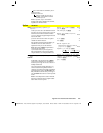
430 Appendix A: Functions and Instructions
8992APPA.DOC TI-89 / TI-92 Plus: Appendix A (US English) Susan Gullord Revised: 02/23/01 1:48 PM Printed: 02/23/01 2:21 PM Page 430 of 132
cZeros()
MATH/Algebra/Complex menu
cZeros(
expression
,
var
)
⇒
list
Returns a list of candidate real and non-real
values of
var
that make
expression
=0.
cZeros()
does this by computing
exp
8
list(cSolve(
expression
=0,
var
)
,
var
)
.
Otherwise,
cZeros()
is similar to
zeros()
.
Note: See also
cSolve()
,
solve()
, and
zeros()
.
Display Digits mode in
Fix 3
:
cZeros(x^5+4x^4+5x^3
ì
6x
ì
3,x)
¸
{
ë
2.125
ë
.612 .965
ë
1.114
ì
1.073
ø
i
ë
1.114
+
1.073
ø
i
}
Note: If
expression
is non-polynomial with
functions such as
abs()
,
angle()
,
conj()
,
real()
,
or
imag()
, you should place an underscore _
(
TI-89:
¥
TI-92 Plus:
2
) at the end
of
var
. By default, a variable is treated as a
real value. If you use
var
_
, the variable is
treated as complex.
You should also use
var
_ for any other
variables in
expression
that might have unreal
values. Otherwise, you may receive
unexpected results.
z is treated as real:
cZeros(conj(z)
ì
1
ì
i
,z)
¸
{1+
i
}
z_ is treated as complex:
cZeros(conj(z_)
ì
1
ì
i
,z_)
¸
{1
ì
i
}
cZeros({
expression1
,
expression2
[
,
…
]
},
{
varOrGuess1
,
varOrGuess2
[
,
…
]
})
⇒
matrix
Returns candidate positions where the
expressions are zero simultaneously. Each
varOrGuess
specifies an unknown whose
value you seek.
Optionally, you can specify an initial guess
for a variable. Each
varOrGuess
must have the
form:
variable
– or –
variable
=
real or non-real number
For example,
x
is valid and so is
x=3+
i
.
If all of the expressions are polynomials and
you do NOT specify any initial guesses,
cZeros()
uses the lexical Gröbner/Buchberger
elimination method to attempt to determine
all complex zeros.
Note: The following examples use an
underscore _ (
TI-89:
¥
TI-92 Plus:
2
) so that the variables
will be treated as complex.
Complex zeros can include both real and
non-real zeros, as in the example to the right.
Each row of the resulting matrix represents
an alternate zero, with the components
ordered the same as the
varOrGuess
list. To
extract a row, index the matrix by [
row
].
cZeros({u_
ù
v_
ì
u_
ì
v_,v_^2+u_},
{
u_,v_
})
¸
1/2
ì
3
2
ø
i
1/2 +
3
2
ø
i
1/2 +
3
2
ø
i
1/2
ì
3
2
ø
i
0
0
Extract row 2:
ans(1)[2]
¸
[]
1/2 +
3
2
ø
i
1/2
ì
3
2
ø
i


















